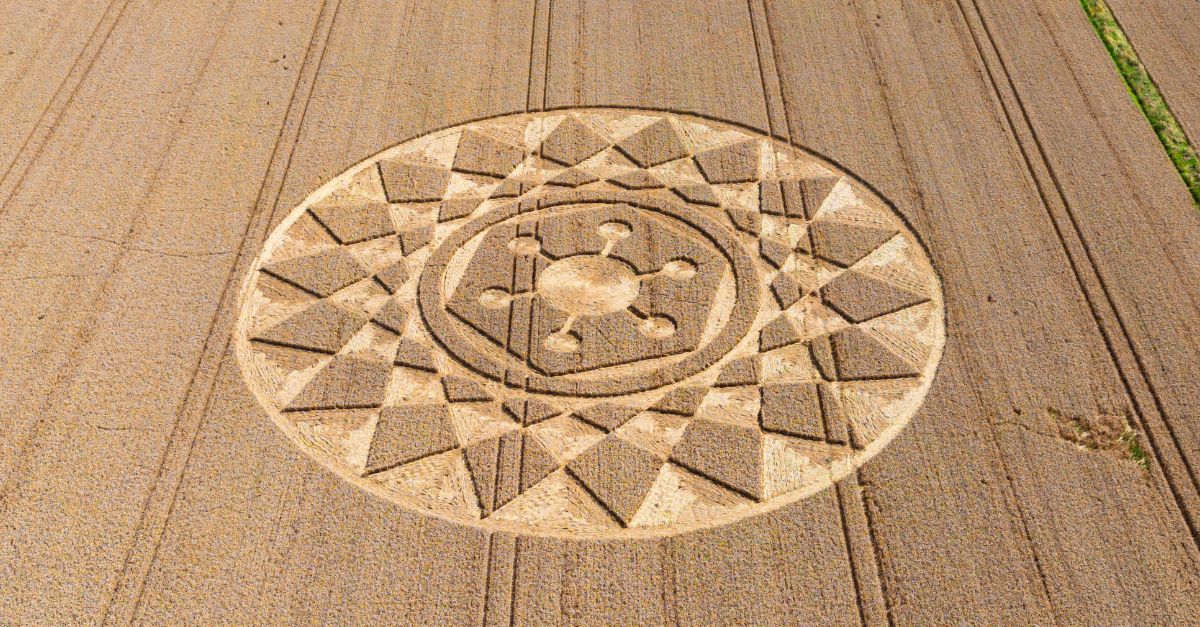But Why!?
Crop circles are perfectly round and, sometimes, intricate geometric designs with unclear beginnings. In most cases, it remains a mind-boggling act, and many still question their purpose.

1. The Very First Crop Circle Unveiled
The very first crop circle was discovered by an amateur astronomer named Patrick Moore. In 1963, as Moore was on his usual hunt for astrological sightings, he noticed something weird. He saw the first crop circle at a distance in Wiltshire, England's landscape.
2. A Circle In The Middle Of A Wheat Field, How?
Finding a few wheat crops flattened can be expected, especially if a tractor passes over them. But this circle of flattened plants was huge, around 20 to 30 feet. That raised eyebrows.
3. Too Big For Comfort
30 feet is equivalent to 1/12th the length of a football field, or 60 hot dogs in a straight line. Yes, we measure in hot dogs. These circles seemed too big to be a coincidence.
4. Then The Theories Came Rolling In
Hugh Ernest Butler, another astronomer, theorized that lightning strikes might have caused these circles. He backed up his argument that lightning strikes had the power to create such patterns. However, more theories were about to come into play.
 EndeavorMoorePhotography, Shutterstock
EndeavorMoorePhotography, Shutterstock
5. A 1678 Tale
The Mowing Devil tale in Hertfordshire describes a wealthy farmer who found perfectly cut circles in his land. All this occurred right after he disagreed with a laborer about the price of mowing the oat field. This frustrated the farmer, and he said…
6. "I'd Rather Have The Devil Mow My Field Then"
Determined not to pay the laborer, the farmer declared the above. Then, lo and behold, the field seemed to be on fire that night, and in the morning, he woke up to the field perfectly mowed in perfect circles.
7. Confused, The People Gave The Devil All The Credit
The neighbors and everyone who saw the circles marveled at their precision and complexity. So much so that it was believed no man could attain that precision hinting that the Devil was behind it.
8. Discrepancies Between The Tale And Reality
In the tale, the crops were cut entirely; in reality, the stalks had only bent. So, was this legend just a story, or did it have a backing? Or was it the laborer who went on a circle drawing venture to anger the farmer? Guess we'll never know.
9. The Patrick Moore Circle Was Just The Beginning
If you thought the Wiltshire incident was it, ohh boy, are you in for a treat. It wasn't. In the 1970s and 1980s, more circles were spotted in several other locations. They weren't the typical simple circles but intricate geometrical shapes this time.
10. How The Designs Evolved
The crop circles discovered were now in spirals, rings, triangles, hexagons, and fractal patterns like the famous Julia Set formation in Stonehenge in 1996. But who was Julia, and what made this marking different?
11. The Julia Crop Set
Unlike the farmer's circles and Moore's discovery, the Julia Crop Set had 151 circles arranged in a spiraling pattern. This entire creation spanned over 920 feet in length and 500 feet in width. That's like 1,840*1,000 hot dogs!
 Garfungled, CC0, Wikimedia Commons
Garfungled, CC0, Wikimedia Commons
12. Julia's Crop Set Circles Varied In Size
The largest circle was about 50 feet in diameter, while the smallest was a foot and two inches. This combination made a fractal design that matched how Julia's Set looked like, hence the name. And the mysterious part is that the circle appeared overnight.
 Ve4cib, CC BY-SA 3.0, Wikimedia Commons
Ve4cib, CC BY-SA 3.0, Wikimedia Commons
13. The Oliver's Castle Event
On the morning of August 11, 1996, a 19-year-old named John Whaley's camera caught an exciting phenomenon. The 15-minute film featured what seemed to be an unidentified sphere of light flying over a wheat field.
 4 season backpacking, Shutterstock
4 season backpacking, Shutterstock
14. Then, A Crop Circle Was Discovered Later
While John was filming, he did not notice the crop circle forming, but when he showed it to his friends later that morning, it was discovered that there was a remnant. That remnant was an intricate crop circle beneath the orbs captured in the footage.
 4 season backpacking, Shutterstock
4 season backpacking, Shutterstock
15. People Doubted The Tape
Of course, people doubted the tape, wouldn't you? However, experts who deemed the footage real affirmed John's credibility. The horizon was steady, and the orbs remained on a fixed height frame after frame, suggesting authenticity.
16. The Crop Circle's Perfect Construction
The Oliver's Castle crop circle was purported to be perfectly crafted, featuring hidden sevenfold geometry designs. For those wondering what a sevenfold shape is, it's a figure with seven sides and seven angles, like a heptagon.
 Droneski Imaging, Shutterstock
Droneski Imaging, Shutterstock
17. Crop Circle Creations Were Assumed To Be Beyond Human
There was no way humans could create such intricate designs with so much precision. Then there was the factor that you would sleep leaving a normal-looking field and wake up to one with stalks bent with circles or other designs. How?
18. So, Who Did It? Aliens?
UFO sightings were quite common in the 1960s when the first crop circle was discovered. Warminster, Wiltshire, England, was quite the hot spot for UFO sightings. Here are some of the known instances of UFO sightings in the area.
19. The 1964 And 1965 Wiltshire Sightings
On Christmas day in 1964, locals attested to hearing strange, loud sounds from the sky. In June 1965, people described seeing sausage-shaped objects with lights flying on the horizon. The other was in August 1967, during the August Bank Holiday.
20. The August Bank Holiday
In this instance, thousands of gathered locals spotted the "Thing." A photographer named Gordon Faulkner presented a picture of a typical flying saucer, which The Daily Mirror published. This brought national and international attention to the area.
 George Stock, Wikimedia Commons
George Stock, Wikimedia Commons
21. A Scientific Take
We all know that scientists are the world's know-it-alls, always on the hunt for information. So, in the 1980s, a biophysicist named Dr William C. Levengood ran an experiment on crop circles, and this is how that went.
22. In 1989, The Experiment Began
Dr. Levengood started by analyzing the plants and soil samples. Then, in 1994, he published a paper detailing his findings on the physical changes he believed to be due to electromagnetic and microwave radiation.
23. His Studies Took Shape With Others Joining The Bandwagon
In 1995, John Burke joined in, and they published a paper titled "Semi-Molten Meteoric Iron Associated with a Crop Circle," exploring the unusual materials in crop circles. Four years later, Levengood paired with Nancy P. Talibott and published another paper.
 Marina Kryuchina, Shutterstock
Marina Kryuchina, Shutterstock
24. "Dispersion Of Energies In Worldwide Crop Formations"
This 1999 paper explored the energy dispersal patterns in crop circles more deeply. The studies concluded that approximately 20% of the crop circles may not have been artificial. But, the next piece of information disputes this theory.
 Hamsterdancer, CC BY-SA 3.0, Wikimedia Commons
Hamsterdancer, CC BY-SA 3.0, Wikimedia Commons
25. A Pair Of Prankstars Taking It A Little Too Far
Meet Doug Bower and Dave Chorley, famous pranksters who claimed to be responsible for crop circles. They claimed to have started their crop-drawing venture in 1976. Doug was a retired artist, and Dave was a former Royal Air Force pilot.
 Kecko, CC BY 2.0, Wikimedia Commons
Kecko, CC BY 2.0, Wikimedia Commons
26. They Had The Right Credentials And Mischievous Motivation
Knowing that they had the right skills—artistry and aviation—they drew inspiration from the growing stories of UFO sightings. With this information, they devised a plan to fool people into thinking that aliens were making trips to Earth. It worked perfectly!
27. Simple Tools, Simple Calculations, Spectacular Results
The pair used simple tools: wooden planks, ropes, garden rollers, and a wire loop. They would use the planks and the garden rollers to flatten the crops and the ropes to measure and maintain symmetry. The wire loop on their caps ensured they walked in straight lines.
28. Dave And Doug Did Quite A Number Of These Night Shifts
Dave and Doug chose to work at night for obvious reasons—to avoid being seen. Their night escapades began in 1976, creating hundreds of crop circles across England. It was in 1991 that they decided to kill the joke.
29. The End Of A Lengthy Hoax
The final work of the pair was in 1991, the same year they decided to end the prank. This last mark of crop circles was near Cheesefoot Head, neighboring the source of it all: Winchester, England.
 Peter Facey, CC BY-SA 2.0, Wikimedia Commons
Peter Facey, CC BY-SA 2.0, Wikimedia Commons
30. The Reception Of Their Confession Was Mixed
Some people were wowed by their creations, while others were disappointed because what was meant to be mysterious had such a simple explanation. Do you remember that people doubted human interaction early on? This brought the argument back to the table.
 Paul Carter Photography, Shutterstock
Paul Carter Photography, Shutterstock
31. The Milk Hill Formation In 2001
About a decade after the prank era ended, the Milk Hill Formation emerged in 2001. This had to be the largest one yet, measuring a diameter of 900 feet. And can you guess the location? Yup, you're right, Wiltshire, England.
 Doug Lee, CC BY-SA 2.0, Wikimedia Commons
Doug Lee, CC BY-SA 2.0, Wikimedia Commons
32. The Milk Hill Formation Designs
This humongous crop circle consisted of 409 circles that interlocked to form a vast spiral shape. The arrangement was so spot on that people doubted humans could be behind this one.
 Brian Nelson, CC BY-SA 2.0, Wikimedia Commons
Brian Nelson, CC BY-SA 2.0, Wikimedia Commons
33. The Pi Representation In 2008
If you've ever stepped into any mathematics class and calculated a circle's area, you know the constant pi (π) number 3.14159. This number measures the ratio of a circle's circumference to its diameter, ironically appearing on a crop circle.
 Gaydukevich Natalya, Shutterstock
Gaydukevich Natalya, Shutterstock
34. Its Location Was Barbury Castle In Wiltshire
This pi formation had unique geometrical designs compared to the previous Milk Formation, differing in size and depiction. The pi formation's most spectacular detail was its portrayal of the first ten digits of the mathematical constant pi (3.1415926535).
 sirk_nala, CC BY 3.0, Wikimedia Commons
sirk_nala, CC BY 3.0, Wikimedia Commons
35. Crop Circles Beyond England
Beyond England, there were more crop circle formations. In 1966, a farmer called George Pedley from Australia stumbled upon a peculiar circle in a swampy area on his farm.
 Rmckenzi, CC BY-SA 4.0, Wikimedia Commons
Rmckenzi, CC BY-SA 4.0, Wikimedia Commons
36. It Was The First Non-England Circle
Until then, there were no crop circle reports elsewhere except England. So, when George met with this anomaly, it was perplexing. The circular patch was 30 feet in diameter, and the typical presentation was of grass bent, not cut or broken.
 Kecko, CC BY 2.0, Wikimedia Commons
Kecko, CC BY 2.0, Wikimedia Commons
37. The Grass Laid Clockwise
A peculiar detail about this Tally crop (or grass) circle is that the grass was flattened clockwise. Instead of looking like a typical circle, it took a unique pattern. Beyond the laid grass, everything seemed normal, pointing to something supernatural.
 Pauline Eccles, CC BY-SA 2.0, Wikimedia Commons
Pauline Eccles, CC BY-SA 2.0, Wikimedia Commons
38. Next Location: Chillicothe, Ohio In The U.S
In July 2003, an American farmer noted unusual patterns on his field. The crop circle description comprises interlocking shapes in detailed arrangements—all precise to the tea. Despite no records of the farmer's name, people still flocked to the area to witness the circle for themselves.
 SANtosito, CC BY-SA 4.0, Wikimedia Commons
SANtosito, CC BY-SA 4.0, Wikimedia Commons
39. Grasdorf, Lower Saxony, Germany
While Doug and Dave were about to reveal their secret, a local German resident found a 250-foot-wide crop circle in his area. Soon after, the media got wind of the news, and people started flooding the farm owned by Farmer Christoph Huttner.
 TUBS, CC BY-SA 3.0, Wikimedia Commons
TUBS, CC BY-SA 3.0, Wikimedia Commons
40. Who Created These Ones?
Of course, when the media arrived, their first question had to be: "Farmer Christoph Huttner, did you create these circles?" He answered with something like, “Nein, es müssen die Schüler in den Sommerferien sein.” This translates to:
41. "No, It Must Be The Students On Summer Holiday"
Farmer Christoph Huttner deflected the blame on the students on a summer holiday at that time. Still, there was no evidence to tie him or the students to the scene, so it remains a conundrum.
42. The Canadian Duhamel, Alberta Crop Circle
In the Canadian region of Duhamel, Alberta, another farmer discovered a crop circle in 1999. This crop circle had interlocking circles on the spots where the wheat crops lay flat. This drew in both crop circle enthusiasts and the media.
 SANtosito, CC BY-SA 4.0, Wikimedia Commons
SANtosito, CC BY-SA 4.0, Wikimedia Commons
43. After The Crop Circle, The Plants Might Keep Growing
The plants might keep growing after all the excitement of a discovered crop circle simmers down. Because they were never broken, most of the plant's systems stay intact. But because they are bent at the base, some grow horizontally.
 CupcakePerson13, CC BY-SA 4.0, Wikimedia Commons
CupcakePerson13, CC BY-SA 4.0, Wikimedia Commons
44. The Plants Might Arise Or Not
Since plants typically grow towards the light through phototropism, some crops recover as if nothing happened. But if the damage was beyond repair, they grow horizontally. This significantly affects the crop's yield, especially if the plot is huge.
 Alan Stewart, Wikimedia Commons
Alan Stewart, Wikimedia Commons



























